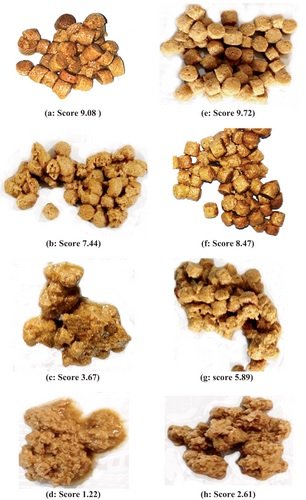The composition of fish feeds is a critical aspect of aquaculture, with dietary protein levels and starch sources playing key roles. These factors not only influence the cost-effectiveness of feed production but also have a profound impact on the physical characteristics of extruded pellets and the overall growth performance of fish.
In an effort to explore the potential for optimizing these variables, researchers from the Islamic Azad University and the Isfahan University of Technology conducted a study to investigate the effects of different dietary levels of wheat flour replacement with corn, at two different dietary protein levels, on the physical quality of extruded feed and the growth of juvenile rainbow trout.
The Experiment
To examine the interaction of protein levels and starch sources in fish feeds, the researchers designed a 2×4 factorial experiment. This resulted in eight distinct feeds, each with varying protein levels and substitutions of wheat flour with corn. A twin-screw extruder machine was used to produce these feeds, which were then fed to 800 rainbow trout.

Results
The study yielded several significant results regarding the effects of variations in protein and starch sources in fish feeding and growth performance:
- Physical Characteristics of Feed Pellets: The use of corn as a starch source was found to reduce the expansion ratio, water stability at 120 and 260 minutes, starch gelatinization, and apparent degradability of the feed. Additionally, the bulk density of the feed pellets increased, as did oil leakage.
- Protein Levels: Feeds with higher protein content exhibited higher bulk density, lower oil leakage, reduced starch gelatinization, and an improved elastic modulus. These findings suggest that higher protein diets result in more compact and durable feed pellets.
- Growth Performance: High-protein diets had a positive impact on the final body weight, weight gain, specific growth rate, and feed conversion ratio (FCR) of the rainbow trout. This indicates that increasing protein levels in the diet leads to improved growth and feed efficiency.
- Starch Source: The use of corn as a starch source not only reduced FCR but also enhanced the trout’s protein efficiency ratio, indicating a more efficient utilization of dietary protein for growth.
- Lipid Proportions and Health: The proportions of lipids in fish livers corresponded to the hepatosomatic index and serum concentrations of aspartate aminotransferase and alanine aminotransferase, which are key indicators of liver health in fish.
Conclusion
In conclusion, this study underscores the importance of protein levels and starch sources in fish feed formulations. It reveals that high-protein diets can enhance the physical quality of feed pellets and significantly improve the growth performance of rainbow trout. Furthermore, the study demonstrates that corn can be used as a starch source to replace a portion of wheat flour in fish feeds without adverse effects on feed pellet quality or fish growth.
“In general, it is recommended to replace wheat flour with corn grain at levels ranging from 33% to 66% in both high and low-protein diets (410 and 380 g kg−1), considering fish growth performance and the physical quality of extruded feeds,” concluded the researchers.
These findings have the potential to not only optimize the cost-effective production of fish feeds but also contribute to the sustainability and efficiency of aquaculture practices.
Contact
Sayed Mohammad Ali Jalali
Department of Animal Sciences, Faculty of Agriculture and Veterinary Medicine
Shahrekord Branch, Islamic Azad University
Shahrekord 8813733395, Iran.
Email: sma.jalali@iaushk.ac.ir; fish.nutritionist@gmail.com
Reference (open access)
Alkoei, A. S., Jalali, S. M. A., Jalali, S. A. H., & Kheiri, F. (2023). Effects of dietary corn and protein levels on physical properties of extruded feed pellets and growth performance of rainbow trout, Oncorhynchus mykiss. Journal of the World Aquaculture Society, 1–24. https://doi.org/10.1111/jwas.13034
Editor at the digital magazine AquaHoy. He holds a degree in Aquaculture Biology from the National University of Santa (UNS) and a Master’s degree in Science and Innovation Management from the Polytechnic University of Valencia, with postgraduate diplomas in Business Innovation and Innovation Management. He possesses extensive experience in the aquaculture and fisheries sector, having led the Fisheries Innovation Unit of the National Program for Innovation in Fisheries and Aquaculture (PNIPA). He has served as a senior consultant in technology watch, an innovation project formulator and advisor, and a lecturer at UNS. He is a member of the Peruvian College of Biologists and was recognized by the World Aquaculture Society (WAS) in 2016 for his contribution to aquaculture.
